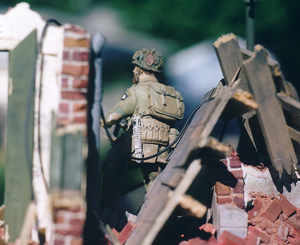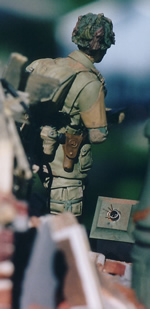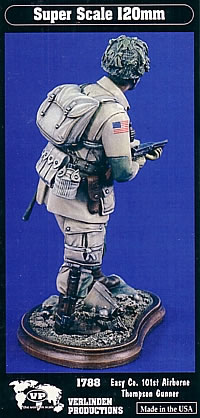 Paint
and Decals Paint
and Decals
It
is easy to get hung up on the "proper" color for uniforms,
and the paratrooper attire is no exception. But I've seen a wide
variety of colors and hues for the M1942 jacket and trousers, everything
ranging from light tan to dark ochre. It's good to keep in mind
that, in most instances, we're looking at uniforms worn 60 years
ago, or recent reproductions. We're not looking at uniforms in their
actual color and state of condition on June 6, 1944. Contemporary
photos of the time are not reliable because of color shifts over
the years, or because the media through which we view the photos
(printed or through the Internet) also has variables. Also keep
in mind these uniforms were impregnated with an anti-gas treatment,
which immediately could have changed the color of the fabric, or
changed it over time in a different way than non-treated uniforms
now look.
  Consequently,
I opted to use Testor's SAC Bomber Tan, which runs a little more
toward tan with a hint of green in its hue. I thought this might
more closely approximate a newer uniform, as I recall reading that
the paratroopers received new uniforms and gear shortly before the
invasion. Consequently,
I opted to use Testor's SAC Bomber Tan, which runs a little more
toward tan with a hint of green in its hue. I thought this might
more closely approximate a newer uniform, as I recall reading that
the paratroopers received new uniforms and gear shortly before the
invasion.
The
reinforcing patches on the elbows and knees, the gussets for the
pockets and their retaining straps were painted a mixture of greenish
grey. The webbing backpack, entrenching tool and bandage pouches
were painted varying shades of khaki green. I used a mixture of
ochre and white for his gloves.
The
relief of the 101st Airborne insignia is pretty sharp, so I just
painted the colors of the eagle patch. I did use an Archer Fine
Transfer for the first aid marking and the U.S. markings from Hudson
& Allen.
One
shortcoming I see in many otherwise fine military figures of any
scale is that the uniforms are often pristine. They don't have that
"lived in" look, dirty and stained with sweat and grime.
I've tried to convey that sense with this figure. Yes, he's been
in combat less than 24 hours, but he's jumped out of an airplane,
landed hard on the ground wet with recent rains, walked through
swamps or flooded fields, worked his way through the bocage, and
clambered through the dusty rubble of this French village. This,
to me at least, is the look of a man in combat.
To
achieve this, I did the usual job of setting down the base coats
of paint and the requisite shading and highlights. I then gave the
trooper a couple of separate turpenoid washes, the first a black
mixture, the second a dark ochre blend. After applying each wash,
I blotted the figure with a piece of paper toweling. This leaves
a slight mottled effect that breaks up the underling base colors
and suggests grime. When thoroughly dry, I sprayed the figure with
flat lacquer to preserve the effect.
Then
I blended some MMP dry pigment powders with some water and stippled
this dirt mixture onto the knees, elbows, boots, and other parts
of the uniform. After this mixture dried, I gave these areas a wash,
which darkened the colors slightly. When dry again, I went over
these areas with a dusting of the powders to bring out some more
detail and suggest drying mud. After the figure was attached to
the vignette base, I sprinkled him with "rubble dust"
made from the MMP's terra-cotta powder, using a wide sable brush
dipped in powder and tapped above and around the figure. This helps
unify him with his current environment.
Introduction
Construction and Detailing
Paint
and Decals
Base and Presentation
|












